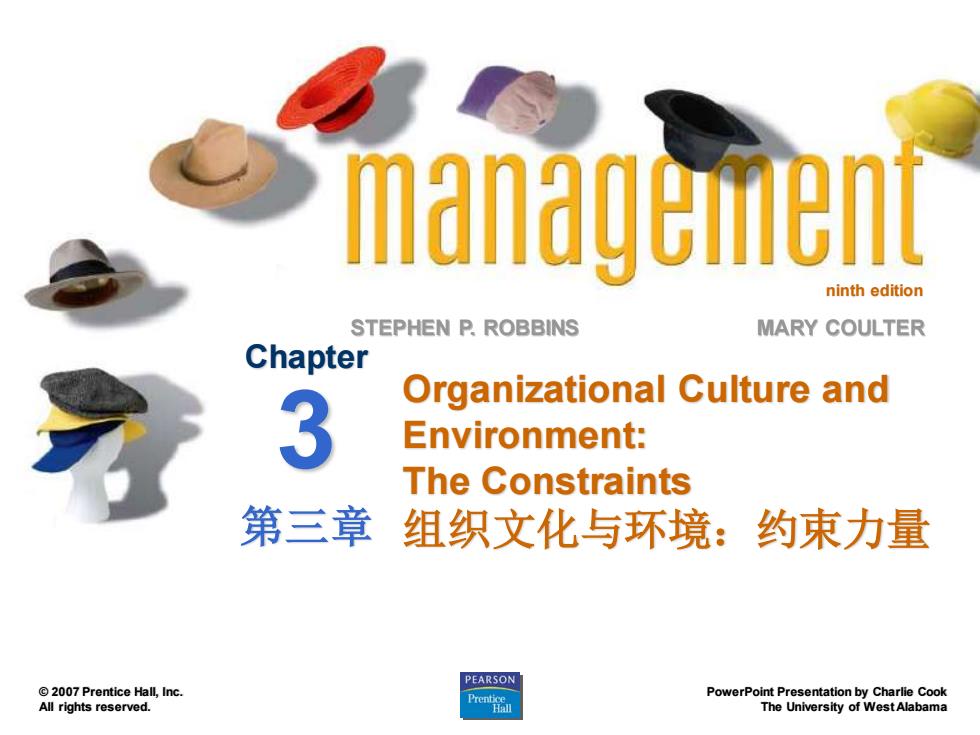
management ninth edition STEPHEN P.ROBBINS MARY COULTER Chapter Organizational Culture and 3 Environment: The Constraints 第三章 组织文化与环境: 约束力量 PEARSON 2007 Prentice Hall,Inc. PowerPoint Presentation by Charlie Cook All rights reserved. The University of WestAlabama
ninth edition STEPHEN P. ROBBINS PowerPoint Presentation by Charlie Cook The University of West Alabama MARY COULTER © 2007 Prentice Hall, Inc. All rights reserved. Organizational Culture and Environment: The Constraints 组织文化与环境:约束力量 Chapter 3 第三章
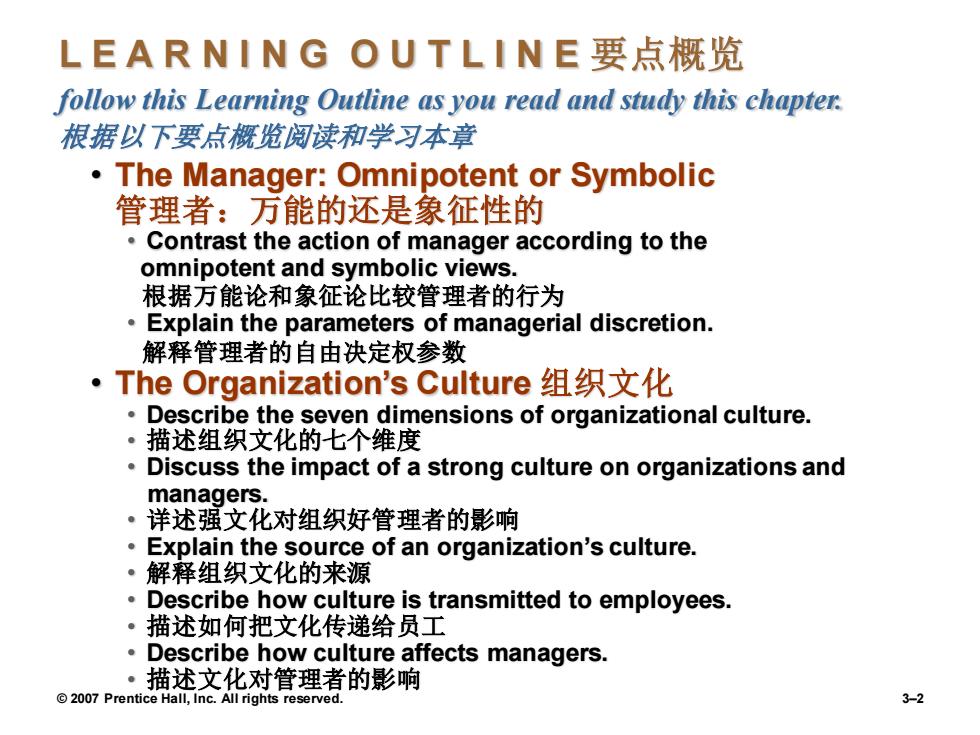
LEARNING OUTLINE要点概览 follow this Learning Outline as you read and study this chapter. 根据以下要点概览阅读和学习本章 The Manager:Omnipotent or Symbolic 管理者:万能的还是象征性的 Contrast the action of manager according to the omnipotent and symbolic views. 根据万能论和象征论比较管理者的行为 Explain the parameters of managerial discretion. 解释管理者的自由决定权参数 ·The Organization's Culture组织文化 Describe the seven dimensions of organizational culture. ·描述组织文化的七个维度 Discuss the impact of a strong culture on organizations and managers. 。 详述强文化对组织好管理者的影响 。 Explain the source of an organization's culture. 。1 解释组织文化的来源 Describe how culture is transmitted to employees. ·描述如何把文化传递给员工 Describe how culture affects managers. 描述文化对管理者的影响 2007 Prentice Hall,Inc.All rights reserved. 3-2
© 2007 Prentice Hall, Inc. All rights reserved. 3–2 L E A R N I N G O U T L I N E 要点概览 follow this Learning Outline as you read and study this chapter. 根据以下要点概览阅读和学习本章 • The Manager: Omnipotent or Symbolic 管理者:万能的还是象征性的 • Contrast the action of manager according to the omnipotent and symbolic views. 根据万能论和象征论比较管理者的行为 • Explain the parameters of managerial discretion. 解释管理者的自由决定权参数 • The Organization’s Culture 组织文化 • Describe the seven dimensions of organizational culture. • 描述组织文化的七个维度 • Discuss the impact of a strong culture on organizations and managers. • 详述强文化对组织好管理者的影响 • Explain the source of an organization’s culture. • 解释组织文化的来源 • Describe how culture is transmitted to employees. • 描述如何把文化传递给员工 • Describe how culture affects managers. • 描述文化对管理者的影响
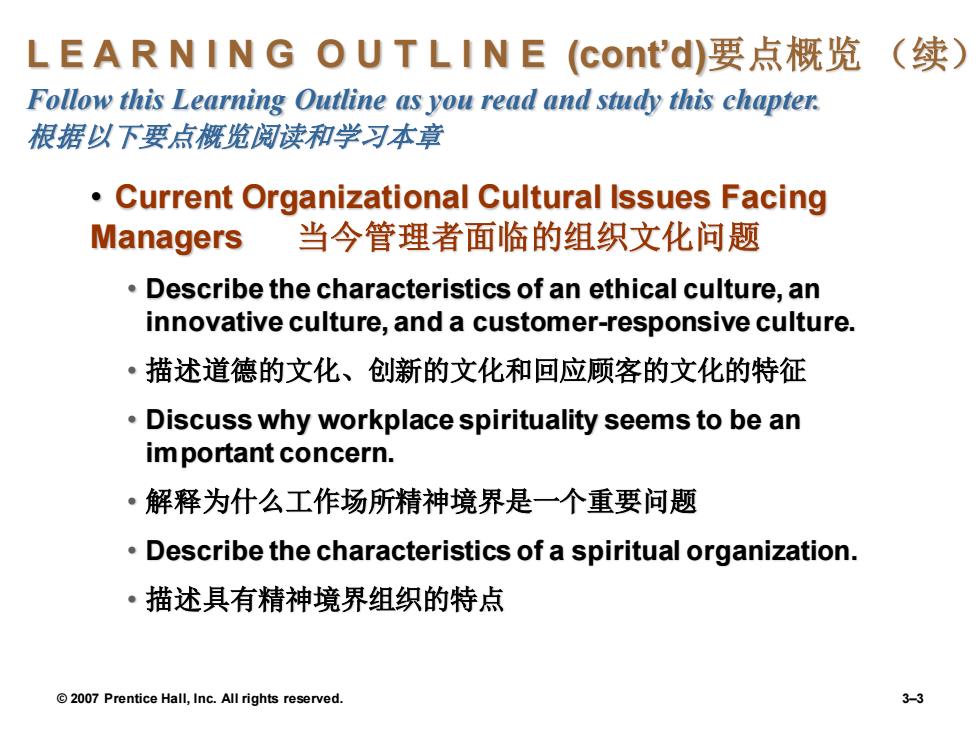
LEARNING OUTLINE(cont'd要点概览(续) Follow this Learning Outline as you read and study this chapter. 根据以下要点概览阅读和学习本章 Current Organizational Cultural Issues Facing Managers当今管理者面临的组织文化问题 Describe the characteristics of an ethical culture,an innovative culture,and a customer-responsive culture. ·描述道德的文化、创新的文化和回应顾客的文化的特征 Discuss why workplace spirituality seems to be an im portant concern. ·解释为什么工作场所精神境界是一个重要问题 Describe the characteristics of a spiritual organization. ·描述具有精神境界组织的特点 2007 Prentice Hall,Inc.All rights reserved
© 2007 Prentice Hall, Inc. All rights reserved. 3–3 L E A R N I N G O U T L I N E (cont’d)要点概览 (续) Follow this Learning Outline as you read and study this chapter. 根据以下要点概览阅读和学习本章 • Current Organizational Cultural Issues Facing Managers 当今管理者面临的组织文化问题 • Describe the characteristics of an ethical culture, an innovative culture, and a customer-responsive culture. • 描述道德的文化、创新的文化和回应顾客的文化的特征 • Discuss why workplace spirituality seems to be an important concern. • 解释为什么工作场所精神境界是一个重要问题 • Describe the characteristics of a spiritual organization. • 描述具有精神境界组织的特点

LEARNING OUTLINE(cont'd要点概览(续) Follow this Learning Outline as you read and study this chapter. 根据以下要点概览阅读和学习本章 The Environment (cont'd) 环境(续) Describe the components of the specific and general environments. ·描述具体环境和一般环境的要素 Discuss the two dimensions of environmental uncertainty. ·详述环境不确定性的两个维度 Identify the most common organizational stakeholders. ·界定最具普遍意义的组织的利益相关群体 Explain the four steps in managing external stakeholder relationships. ·解释管理外部利益相关群体关系的四个步骤 2007 Prentice Hall,Inc.All rights reserved. 3-4
© 2007 Prentice Hall, Inc. All rights reserved. 3–4 L E A R N I N G O U T L I N E (cont’d)要点概览 (续) Follow this Learning Outline as you read and study this chapter. 根据以下要点概览阅读和学习本章 • The Environment (cont’d) 环境(续) • Describe the components of the specific and general environments. • 描述具体环境和一般环境的要素 • Discuss the two dimensions of environmental uncertainty. • 详述环境不确定性的两个维度 • Identify the most common organizational stakeholders. • 界定最具普遍意义的组织的利益相关群体 • Explain the four steps in managing external stakeholder relationships. • 解释管理外部利益相关群体关系的四个步骤

The Manager:Omnipotent or Symbolic? 管理者:万能的还是象征的 ·Omnipotent View of Management管理万能论 >Managers are directly responsible for an organization's success or failure. >管理者对组织的成败负有直接责任 >The quality of the organization is determined by the quality of its managers >一个组织的管理者的素质决定了这一组织本身的素质 >Managers are held accountable for an organization's performance yet it is difficult to attribute good or poor performance directly to their influence on the organization. 管理者被认为要对组织的绩效负责,但是很难将良好的或是不好 的绩效直接归因于管理者在组织中的影响。 2007 Prentice Hall,Inc.All rights reserved. 3-5
© 2007 Prentice Hall, Inc. All rights reserved. 3–5 The Manager: Omnipotent or Symbolic? 管理者:万能的还是象征的 • Omnipotent View of Management 管理万能论 ➢ Managers are directly responsible for an organization’s success or failure. ➢ 管理者对组织的成败负有直接责任 ➢ The quality of the organization is determined by the quality of its managers. ➢ 一个组织的管理者的素质决定了这一组织本身的素质 ➢ Managers are held accountable for an organization’s performance yet it is difficult to attribute good or poor performance directly to their influence on the organization. ➢ 管理者被认为要对组织的绩效负责,但是很难将良好的或是不好 的绩效直接归因于管理者在组织中的影响
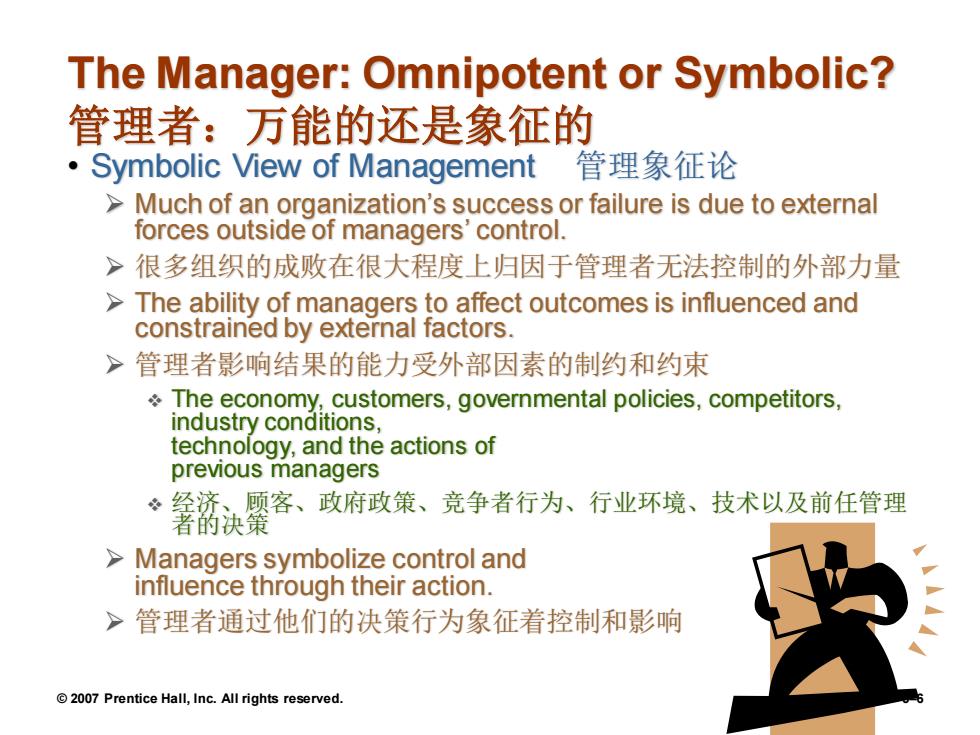
The Manager:Omnipotent or Symbolic? 管理者:万能的还是象征的 ·Symbolic View of Management管理象征论 >Much of an organization's success or failure is due to external forces outside of managers'control. >很多组织的成败在很大程度上归因于管理者无法控制的外部力量 The ability of managers to affect outcomes is influenced and constrained by external factors. >管理者影响结果的能力受外部因素的制约和约束 The economy,customers,governmental policies,competitors, industry conditions, technology,and the actions of previous managers ·经济、顾客、政府政策、竞争者行为、行业环境、技术以及前任管理 者的决策 >Managers symbolize control and influence through their action. >管理者通过他们的决策行为象征着控制和影响 2007 Prentice Hall,Inc.All rights reserved
© 2007 Prentice Hall, Inc. All rights reserved. 3–6 The Manager: Omnipotent or Symbolic? 管理者:万能的还是象征的 • Symbolic View of Management 管理象征论 ➢ Much of an organization’s success or failure is due to external forces outside of managers’ control. ➢ 很多组织的成败在很大程度上归因于管理者无法控制的外部力量 ➢ The ability of managers to affect outcomes is influenced and constrained by external factors. ➢ 管理者影响结果的能力受外部因素的制约和约束 ❖ The economy, customers, governmental policies, competitors, industry conditions, technology, and the actions of previous managers ❖ 经济、顾客、政府政策、竞争者行为、行业环境、技术以及前任管理 者的决策 ➢ Managers symbolize control and influence through their action. ➢ 管理者通过他们的决策行为象征着控制和影响
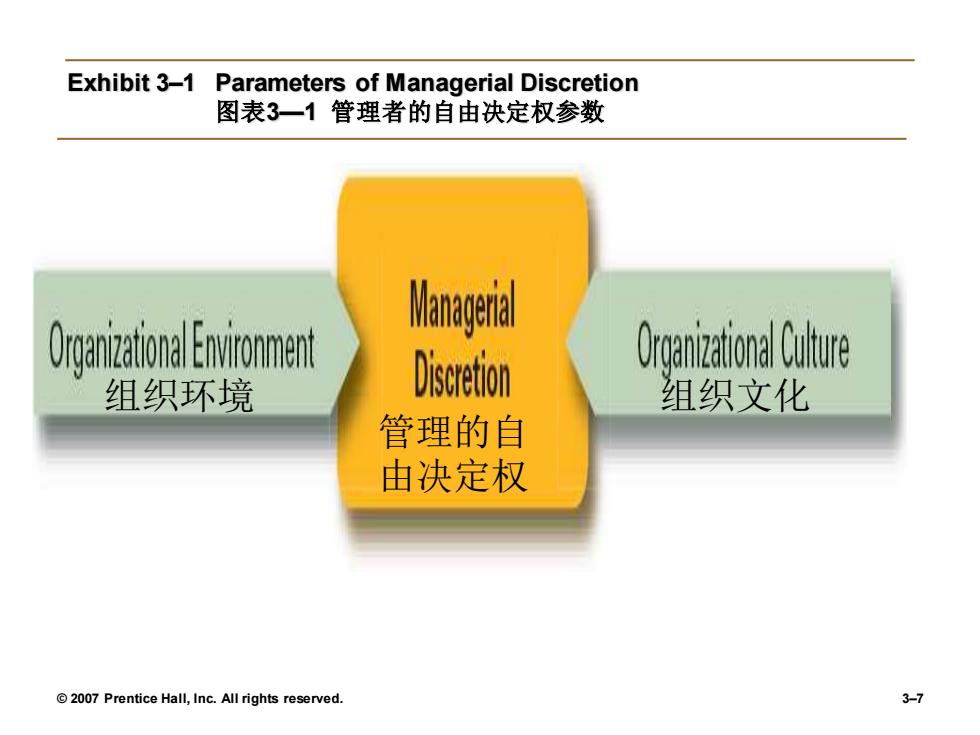
Exhibit 3-1 Parameters of Managerial Discretion 图表3一1管理者的自由决定权参数 Maera anionEnt aCuture 组织环境 Disretio 组织文化 管理的自 由决定权 2007 Prentice Hall,Inc.All rights reserved. 3-7
© 2007 Prentice Hall, Inc. All rights reserved. 3–7 Exhibit 3–1 Parameters of Managerial Discretion 图表3—1 管理者的自由决定权参数 组织环境 组织文化 管理的自 由决定权
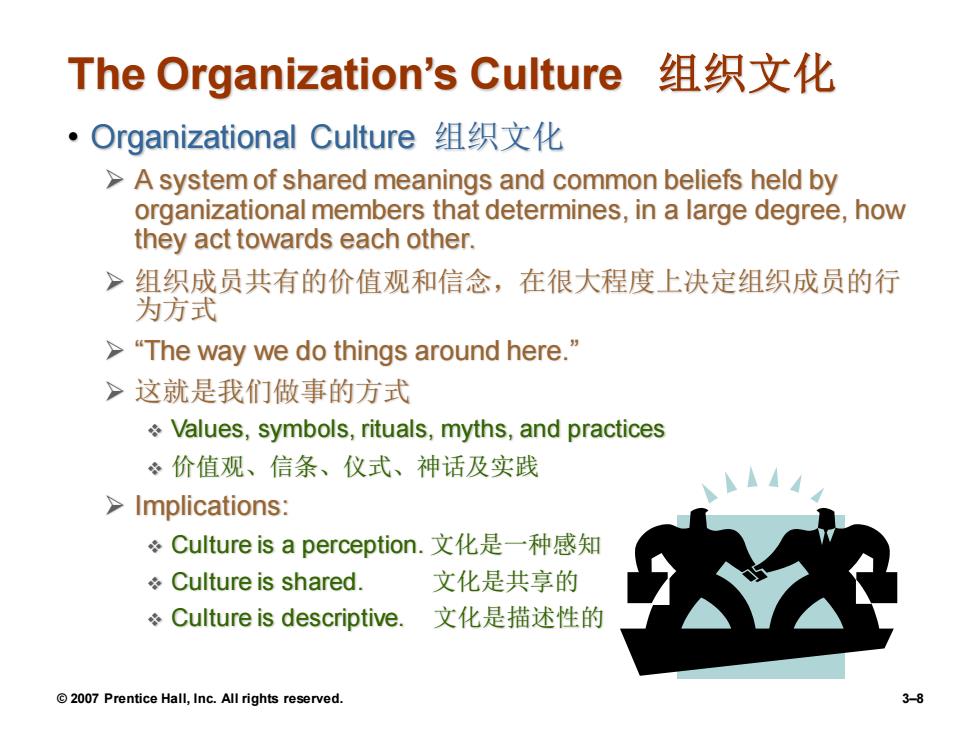
The Organization's Culture 组织文化 ·Organizational Culture组织文化 >A system of shared meanings and common beliefs held by organizational members that determines,in a large degree,how they act towards each other. >组织成员共有的价值观和信念,在很大程度上决定组织成员的行 为方式 >"The way we do things around here." >这就是我们做事的方式 Values,symbols,rituals,myths,and practices 冬价值观、信条、仪式、神话及实践 Implications: Culture is a perception.文化是一种感知 Culture is shared. 文化是共享的 Culture is descriptive. 文化是描述性的 2007 Prentice Hall,Inc.All rights reserved. 3-8
© 2007 Prentice Hall, Inc. All rights reserved. 3–8 The Organization’s Culture 组织文化 • Organizational Culture 组织文化 ➢ A system of shared meanings and common beliefs held by organizational members that determines, in a large degree, how they act towards each other. ➢ 组织成员共有的价值观和信念,在很大程度上决定组织成员的行 为方式 ➢ “The way we do things around here.” ➢ 这就是我们做事的方式 ❖ Values, symbols, rituals, myths, and practices ❖ 价值观、信条、仪式、神话及实践 ➢ Implications: ❖ Culture is a perception. 文化是一种感知 ❖ Culture is shared. 文化是共享的 ❖ Culture is descriptive. 文化是描述性的
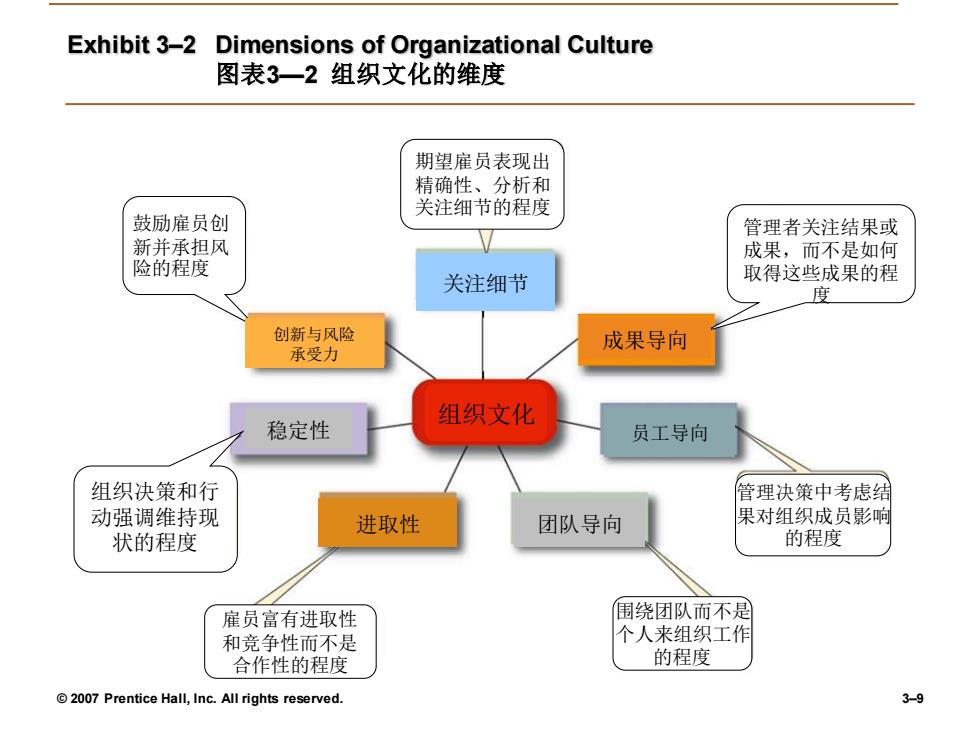
Exhibit 3-2 Dimensions of Organizational Culture 图表3一2组织文化的维度 期望雇员表现出 精确性、分析和 关注细节的程度 鼓励雇员创 管理者关注结果或 新并承担风 成果,而不是如何 险的程度 关注细节 取得这些成果的程 度 创新与风险 成果导向 承受力 稳定性 组织文化 员工导向 组织决策和行 管理决策中考虑结 动强调维持现 进取性 团队导向 果对组织成员影响 状的程度 的程度 雇员富有进取性 围绕团队而不是 和竞争性而不是 个人来组织工作 合作性的程度 的程度 2007 Prentice Hall,Inc.All rights reserved. 3
© 2007 Prentice Hall, Inc. All rights reserved. 3–9 Exhibit 3–2 Dimensions of Organizational Culture 图表3—2 组织文化的维度 鼓励雇员创 新并承担风 险的程度 管理者关注结果或 成果,而不是如何 取得这些成果的程 度 组织决策和行 动强调维持现 状的程度 期望雇员表现出 精确性、分析和 关注细节的程度 雇员富有进取性 和竞争性而不是 合作性的程度 围绕团队而不是 个人来组织工作 的程度 管理决策中考虑结 果对组织成员影响 的程度 关注细节 创新与风险 承受力 成果导向 稳定性 员工导向 进取性 团队导向 组织文化
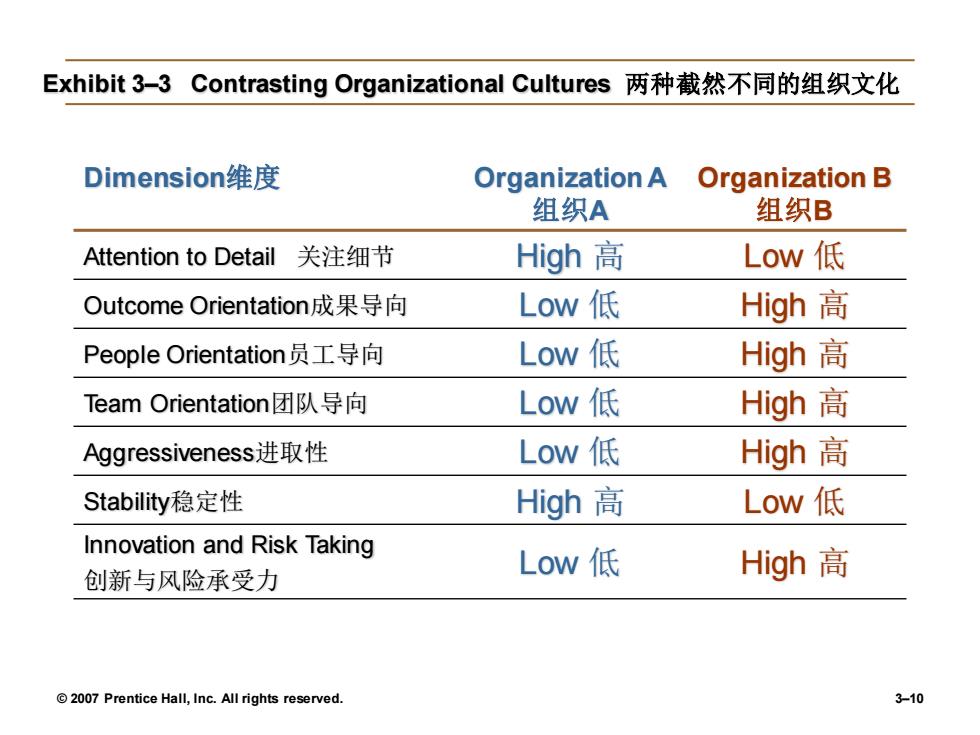
Exhibit3-3 Contrasting Organizational Cultures两种截然不同的组织文化 Dimension维度 Organization A Organization B 组织A 组织B Attention to Detail关注细节 High高 Low低 Outcome Orientation成果导向 LoW低 High高 People Orientation员工导向 LoW低 High高 Team Orientation团队导向 Low低 High高 Aggressiveness:进取性 LoW低 High高 Stability稳定性 High高 LoW低 Innovation and Risk Taking 创新与风险承受力 LoW低 High高 2007 Prentice Hall,Inc.All rights reserved. 310
© 2007 Prentice Hall, Inc. All rights reserved. 3–10 Exhibit 3–3 Contrasting Organizational Cultures 两种截然不同的组织文化 Dimension维度 Organization A 组织A Organization B 组织B Attention to Detail 关注细节 High 高 Low 低 Outcome Orientation成果导向 Low 低 High 高 People Orientation员工导向 Low 低 High 高 Team Orientation团队导向 Low 低 High 高 Aggressiveness进取性 Low 低 High 高 Stability稳定性 High 高 Low 低 Innovation and Risk Taking 创新与风险承受力 Low 低 High 高